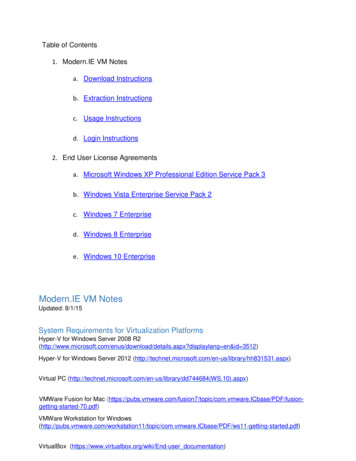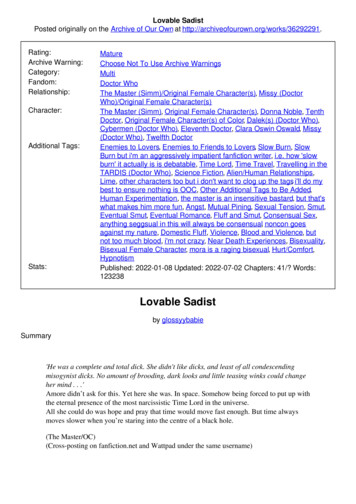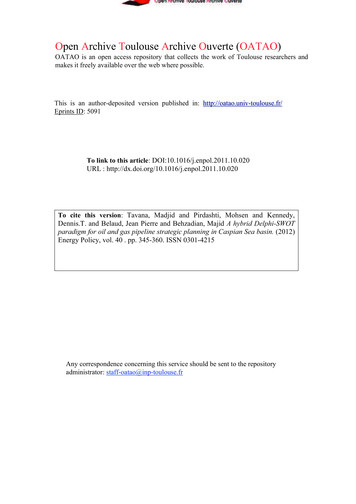
Transcription
mumsm
A Book for PeopleWho Like People& North CarolinaBy Jim Chaney. Foreword by Sam RaganDesigned and illustrated by Dave BurngasserA hard-cover book with more than 250 pages, original drawings and attractivedust jacket, published by Moore Publishing Company of Durham, containingmorethan90favoritestories,poems andarticles from Carolina Countrymagazine.On sale in bookstores at 5.95 per copy. You can assure yourself of a copy and of copies to send to friends and give as Christmas gifts — at a special CarolinaCountry price of only 5 per copy (including tax and postage) by using thecoupon below.Please send me copies of CAROLINA COUNTRYREADER( 5.00 each).Total amount enclosed .NameStreet or RouteCity State ZipMail this coupon with check, money order or cash to:CAROLINA COUNTRY READERP. O. Box 1699, Raleigh, N. C. 27602Carolina Country Reader i:awarm and friendly book, a casilbook to be read for pleasure adkept at hand for sampling tyour leisure. It's a book for Iwho love North Carolina, rtonly those who live here regui ly, but also for those who vartion here, or have lived here, rhave been through the state cdwish they could have stayed.But most of all, Carol qCountry Reader is a book reverybody who has a place in isheart for the thoughts and thi gsthat keep the boy alive in 'eman and the girl alive in iewoman.2CAROLINA COUNTRY DECEMBER, 173
Carottna Country;Read Monthly in More than 210,000 Homes.Vo I. 5No. 12.December, 1973Formerly The Carolina Farmer.P.O. Box 1699 Raleigh, N.C. 27602Your EMC's MagazineJames A. Chaney, EditorMay This Christmas Be Your BestOwen BishopAssociate Editor-Advertising ManagerBrenda SargentWhen I was younger writing Under the DomeI’d try each Christmas to fashion a poemAbout the people 'round Capitol Square,Laboriously fitting each name to rhymeTo wish all the best at Christmas time.Carolina Homemaker EditorOfficial PublicationNorth Carolina ElectricMembership CorporationRobert N ClevelandExecutive Vice President & General Manager'.OVER — Tingling with anticipation,ihe children arrive at Grandaddy's.ouse and race to the porch to throwIhemselves into his arms. Grandnanny, busy in the kitchen. Mama and)addy will follow as soon as they'veinloaded the family car. In the Grandita Moses manner, artist Dot Stelllortrays a scene which is a Christmasadition throughout Carolina Couny. For those Tar Heels lucky enougha have known the happiness of it,hristmas with their grandparents is aiemory to be cherished even untiltey are grandparents themselves.?is Month . . .YOU AND YOUR GOVERNMENTTHE REAL CHRISTMASTILL THE DOCTOR COMESTHE CAROLINA HOMEMAKERCONSUMER NEWSTHE POET'S CORNER: EARTH WALK- --'' r--——--—(ROLINA COUNTRY (formerlyTHE1 ROLINA FARMER) IS RPORAON. SECOND CLASS POSTAGE PAIDRICHMOND, VA„ 23219. EDITORIAL FICES, SUITE 911, BRANCH BANKIjLDING, RALEIGH, N.C. 27602. POSTf STER, SEND FORM 3679 TO BOXRALEIGH,N.C.27602.EMC(OUP SUBSCRIPTIONS, 75 CENTS AWR, INDIVIDUALS 1. ADDRESS ALLNil TO: CAROLINA COUNTRY, BOX1 9, RALEIGH, N.C. 27602.}II’m not up to versifying at the moment, but the Christmas moodis on me, and I want to share the spirit of it and send greetings, albeitin prose:To Governor Jim Holshouser and Lieutenant Governor Jim Hunt.Both deserve a vote of thanks for their efforts in behalf of the peopleof North Carolina.To Speaker of the House Jim Ramsey and the other members ofthe State House of Representatives, and to Senate President ProTern. Gordon Allen and the other members of the State Senate. Theyshowed in the 1973 General Assembly that our legislators as a bodyput North Carolina first.To the hard-working members of the State Supreme Court,members of the State Court of Appeals, Superior Court judges andDistrict Court judges. May their dockets be lighter.To U.S. Senator Sam Ervin Jr. and U.S. Senator Jesse Helms, withpersonal best wishes to both.To Congressmen Walter Jones, I H. Fountain, David Henderson,Ike Andrews, Wilmer Mizell, Richardson Preyer, Charles Rose, EarlRuth, James Martin, James Broyhill and Roy Taylor, with apprecia tion for their concern for rural people.To Attorney General Bob Morgan, for courage in the public’sbehalf; likewise to Hugh Wells and his fellow Commissioners.To my old friends Thad Eure, Jim Graham, Edwin Gill and HenryBridges, and also Billy Creel, John Ingram, Dr. Craig Phillips and theappointive members of Governor Holshouser’s C abinet.To the directors, managers and employees of all of our electriccooperatives and telephone cooperatives, tor dedicated seivice totheir members and communities.To the newest members of the Carolina Country family, theNorth Carolinians served by Blue Ridge Mountain EMC .To all readers of Carolina Country, and to all who love NorthCarolina and Christmas.May you know this Christmas every joy of Christmas and may theNew Year bring you lasting happiness.( ROLINA COUNTRY DECEMBER, 1073mJim Chaney3
YOU AND YOUR GOVERNMENTA Report by Rep. David N. Henderson, Third DistrictThis is the fifth in a series of messages prepared for CarolinaCountry by members of North Carolina’s Congressional delegationAs the Third District’s Congressman, Representative Henderson serves the people of Bladen,Duplin, Harnett, Johnston, Lee, Onslow, Pender, Sampson and Wayne counties. His home address isWallace. His district offices are in Goldsboro.Following the 1960 census, the Commerce Department published a list of ruralcongressional districts. Based on its statistical definition of the term “rural,” it foundthat the Third District of North Carolina, which I have had the honor to represent forthirteen years, was one of the most rural districts in the United States. 1, frankly, have been proud of that fact and have alluded to it many times in talking to colleagues,informally or in debate, on the House floor.Like others who have lived all their lives in rural areas, 1 have tended to feel thaturban blight, characterized by run-down, slum housing, ugly commerical centers,crowded traffic, overloaded water and sewer systems, factory smoke and grit permeatingthe air, and rivers and streams filled with scrap and waste of all kinds and descriptions,were things which existed in the major industrial cities of the rest of the country andcould not happen to us.However, they are happening to us. As I travel through the nine counties of theThird District today, 1 see more and more signs of these very things. These are mobilehomes scattered everywhere, both singly and in parks and large subdivisions.Abandoned motor vehicles, pieces of farm equipment or other debris are prominent onalmost every rural road. In our cities and towns, there is evidence of the same kind ofdowntown decay and surburban growth at the fringes which has become characteristicof northern cities. Large areas of our tidal waters are so polluted that they are closed toshell-fishing and not even suitable for swimming.Most of useven those considerably younger than Ican point to spots where wehunted, fished or enjoyed outdoor sports as youngsters and which are now cleared anddeveloped residentially, commercially, or both.I am not one of those who lives under the illusion that we can and should try tomake our country what it was in the days of the early settlers in North Carolina andelsewhere in the South. However, 1 do feel that we, in eastern North C arolina, have theobligation totryto preserve something of our unspoiled, rural heritage lor ourgrandchildren and future generations.Nobody blames a landowner for using his land in the manner he deems mostprofitable. However, if we all continue to do that, without any regard for ourenvironment and for other people, eventually, we will face increasing land controls atevery level of government. Hopefully, the people of eastern North Carolina will beconcerned enough about this problem to begin to work today toward local solutionswhich are fair to all concerned.4CAROLINA COUNTRY DECHMBER. 73
TO FINANCE THE HOMES WE BUILDDon’t wait! Jim Walter has cut the strings on tight money. Millions of dollars areavailable right now for new homes constructed by Jim Walter Homes.Get in on the savings. Build now! Avoid the rising costs of materialand labor. Labor and material costs continue to rise eachyear. Build now and realize tremendous savings inincreased property values.Immediate construction for qualified property owners.Just add your property to our barrels of INSTANT Mortgage Money and you’ll realize one of the besthome buys in America today. Jim Walter will help you cut your new home cost even more by makingit possible for you to do some of your own interior finishing. You decide how much. The more you do,the more money you save.COME IN AND OPEN UP ONE OF OUR BARRELS OF INSTANT MORTGAGE MONEY.DIP IN. TAKE WHAT YOU NEED FOR YOUR NEW JIM WALTER-BUILT HOME.ASHEVILLE, N.C. 28802WILMINGTON, N.C. 28401GREENSBORO, N.C. 27407 P.O. Box 120474 Tunnel RoadPhone 298-5094P.O. Box 11675815 Market St.Phone 799-3657ROCKY MOUNT, N.C. 27801P.O. Box 1897Hwy. 301 SouthPhone 446-9128P.O. Box 72183025 Highpoint Rd. *Phone 292-0261CHARLOTTE, N.C. 28208P.O. Box 804615101 Wilkinson Blvd.Phone 399-8317HICKORY, N.C. 28601 P.O. Box 5461350 Hwy. 70 S.W.Phone 328-1811‘IZABETH CITY, N.C. 27909MOUNT AIRY, N.C. 27030P.O. Box 572iighes Blvd. & Main St.Phone 335-4252P.O. Box 454W. Lebanon St.Phone 786-4181AYETTEVILLE, N.C. 28306P.O. Box 4153Hwy. 301I Phone 485-6111/J' OPEN 8 'til 8 Weekdaysundo*OPEN til 6 PMSat. & Sun.To reserve your barrel of mortgagemoney, come by, call or mail thecoupon to the nearest Jim WalterHomes display park.!JIM WALTER HOMES(Mail to nearest office)I would like to have moreinformation and the cost ofbuilding on my property . Iunderstand there would beno obligation to buy andthat you would give me thesefacts free of charge.NAME ADDRESSNEW BERN, N.C. 28560CITY STATEP.O. Box 2372Kinston Hwy. WestPhone 638-1105Telephone (or neighbors)If rural route please give directions . I own property inCounty.
had to be done at approximately thesame hour every morning and everyTheReal MeaningOf Christmasnight.We took the two containers of milkto the kitchen. Then we decided to go,feed the hogs - with several ears ofcorn and a big bucketful of slop — andbring fresh drinking water from the!By Bill HumphriesIt happened years ago, in the days ofthe Big Depression, when I was aboy growing up on the hilly PersonCounty farm where my parents andtheir brood of eight childrensixboys and two girls - were trying toeke out a living.During one particular year of thosetrying times, my most unforgettableChristmas occurred. It really wasn’t a“big deal.” I didn’t catch my firstglimpse of Santa Claus that year, nordid I find a shiny new bike under theChristmas tree next morning. In fact,there wasn’t any tree, for we had noelectric power on the farm in thosedays and we couldn't decorate a treeproperly.My “special” Christmas - perhapslong since forgotten even by myremaining brothers and sisterscameabout as the result of a suggestion bymy brother Earl. He and 1 were quiteclose during our growing-up periodbecause we were only a couple ofyears apart in age (he was older), andwe shared many boyhood experiences.My father, who seemed to us boysto possess a remarkable talent for“thinking up jobs” to keep us occu pied during the days and hours whenwe weren’t in school, always set asidethe day before Christmas as wood sawing time. A Fordson tractor fur nished power for the circular saw.Pine, sawed in to 15-inch lengths, wasto be split later, as needed, for use inthe cookstove. Hardwood, about twicethat length, was for the fireplace.Once the wood-sawing was com pleted,usuallyby about mid afternoon, and the tools and equip ment put away, we were assignedvarious other jobs around the houseand yard. On this particular day, Earlmotioned me aside for a conference.6“Why don’t we give everybody aChristmas surprise and get up realearly tomorrow morning and do all thechores?” he asked.“Do you really mean it?” I wantedto know. He replied he did.Somehow, the idea appealed to me.We agreed to keep our little plan secretand to get up at 4 o’clock Christmasmorning to get started.Earl and 1 giggled at the supper tablethat night as we exchanged knowingglances, delighting in the fact thatthose we intended to help didn’t havethe slightest idea of what was afoot.With no alarm clock, how did wemanage to wake ourselves up at 4a.m.? I don’t know. Perhaps it wassheer excitement that caused us toawake to the agreed-upon time.We dressed in the darkness of ourroom and then quietly went down stairs to the back porch to get akerosene lantern. Once out of the houseand beyond the woodshed, we used abig wooden kitchen match to light thelantern.The first chore was feeding thethree mulesDave, an aging, slow andimperturbable plodder; Dan, young,quick and fiery in temperament; andMary, the unpredictable female.Each mule received a few ears ofcorn and a couple of armfuls of dryfeed that consisted of chopped-upcorn stalks and leaves. Later, duringthe day when it was warmer, theanimals would be let out to pasteurand water.The next job on our list was feedingand milking the two family cows. Thiswas no problem, since both Earl and Iknew how to milk. In fact, milkingwas a chore handed down from theoldest child to the next and the next,and so on. Other chores could be doneahead of time, or put off, but milkingspring.By this time, Mom and Dad were up, and of course they wondered whatrion earth was going on. We told them,!but asked them not to say anything to! ithe rest of the family until we had!finished carrying out our plan.Splitting stovewood and bringingin wood for the fireplace were the twcremaining jobs that had to be dornibefore breakfast. We finished them iishort order.Santa Claus, who really had a rouglgo of it during the Depression, managed to provide for each of us boy!and girls a few goodies in a stockingan orange, an apple, and a few raisinand pieces of hard candy. But as fcltoys - well, only the younger childreireceived any of them. Things likerubber ball, a toy farm well, andsmall, wind-up type motorcycle th;went around in a circle were typicalSomehow these don’t sound veiexciting when compared with the pre, ;ients that today’s children get, but the; ireally meant something back durir; )the “hard times” of the early 1930!' jThe younger children — Joe, RubTommyreceived toys on Christmmorning this particular year. Thewere all awake, young and old, by tltime Earl and I brought in wood f istove and fireplace.Dad, who usually fed the hogs aibrought fresh water from the sprirwas surprised to find the bucketslop gone and the wooden bucketdrinking water full.“Who did all this?” he asked.“Earl and I did,” I said. “We rea ,pulled one over on you, didn’t we?”Dad admitted that we had.Then Earl spoke up and told eveone that all the chores had been doi“But why? Why did you do 1that?” asked Clarence, our old;brother.“I don’t know,” Earl said. “1 gu 1we wanted to do a little someth?special this Christmas. Besides, dodown, it gives you a good feeling wf1you know you’re helping others.”CAROLINA COUNTRY DECEMBER, 19
The memory of that particularChristmas has meant much to me overthe years. It still brings a warm glow tomy heart.Why is the memory so vivid? Whydoes that Christmas, of all the Christ mases I have experienced, stand out assomething special?Perhaps the reason is that I learned,under special circumstances and in anunforgettable way, the real joy thatcan come to a person who gives - notmoney or material possessions or any thing money can buy - but who givesa part of self.In so many families today, childrensimply inform their parents weeksahead of time as to exactly what theywant for Christmas. And the parentscomplywith their wishes. OnChristmas morning the desired giftusually is there, but seldom is there anelement of surprise, nor does thegiving seem to bring to parents thewarm glow, the feeling of satisfactionthat it should bnng.Many parents today may feel likeclerks in a catalogue order store. Thechild comes up, places his order, andeventually gets exactly what he hasordered.Throughout history, men (andwomen too) have attempted toneasure their lives — their jobs, theirnarriages, their roles as parents — int:erms of material things.We live in the midst of a materialvorld, and — short of death - there is10 way we can escape it completely.But can’t we at least at Christmas,ry to place the emphasis and focushe attention on things that are moremportant than the material?At this Yuletide season, let us joinvith the Psalmist (51:7) in this simpleirayer:“Create in me a clean heart, O God;nd renew a right spirit within me.”ISuch a prayer can change lives. Itin change a world.A “right spirit” would include the;t alization of that eternal truth fromJ le New Testament: “It is moreessed to give than to receive.”Especially when one gives, notver or gold or anything that theseecious metals may buy, but whenie gives of himself.To me, that is the real meaning ofiristmas.AROUNA COUNTRY DECEMBER, 1973IThe first chore was feeding the three mules.
He, and many others, see this asone element in a combination ofapproaches.Physician extender clinics alreadyin operation are located in ProspectHill, Haywood-Moncure, Chapel Hill.Rougemont-Bahama, Madison County.Walstonburg, and Farmington.The Walstonburg clinic is a goodexample of what such a clinic can beIt has been operating for six monthsunder the guidance of family nursepractitioner Miss Donna Schafer.The clinic is housed in a verymodern cedar building, with brightcolors and lots of space, designed bytire Community Development Group;of the School of Design at N.C. State;University.It offers physical examinations, thitreatment of acute minor conditions!follow-up on chronic conditions sue!as diabetes and hypertension, immumzations, suturing of minor lacerations!lab service. Pap smears, electrccardiagrams, “almost every diagnosiand treatment that can be done inregular doctor’s office,” Miss Schafelexplained.There are four people on the stafIn addition to the family nurse practtioner, there is a licensed practicenurse, a health worker, andsecretary-receptionist. The familnurse practitioner is a registered nurs'jwith six months of additional specietraining and a six-month internshipMiss Schafer spent two years in th jPeace Corps in Bolivia, and holds ijmaster’s degree in community nursingWalstonburg's family nurse practitioner Donna Schafer with patient.Till the Doctor ComesBy Peggy PayneWhat can be done to provide peoplein communities without doctors ameasure of medical care?Governor JimHolshouser hasrecommended,aspartof amulti-pronged program to deal withthe problem, a system of communityhealth clinics staffed by “physicianextenders.”The term refers to family nursepractitioners and physicians’ assistantswho would operate the clinics undersupervision of nearby doctors.As a first phase in the “physicianextender” clinic plan, five communityclinics are to open in a year at Bakersville in Mitchell County, East Bend inYadkin County, Newton Grove in8Sampson County, Whitakers in Edge combe County, and on the OuterBanks in Dare County.James Bernstein, chief of ruralhealth services in the State Depart ment of Human Resources, says thelocations of five other communityclinics will be announced in January.But North Carolina already has ahandful of clinics of this kind. Fewhealth professionals see the concept asthe one answer to doctor shortages.The attitude is generally that it is onepart of a solution. “It’s not a goodanswer, but it’s something there whenyou need it,” said John Payne of thedivision of community medical careunder the University of North CarolinaMedical Center. “But it’s better thannothing.”Walstonburg has about 200 people! jthough the clinic serves the wholarea. There are no geographic limits fthe service area. People came frorGreene County and from the suirounding counties. The average now iabout 10 patients a day.There are no doctors in Walstonburg and the only one in the county ia general practitioner in Snow Hil!“People would go to Farmville oWilson or Kinston or Goldsboro,Miss Schafer said. “There was a doetdhere, but he died 10 or 11 years ago.Wilson doctors provide back-up f(the clinic, coming regularly, seeiripatients that are referred by the nursiThere is ’’almost daily contactwith the doctors. “If there weienough doctors to go around, it woulbe fine to have one here,” Miss Schafsaid. “But nurses have always macCAROLINA COUNTRY DECEMBER, 197
itJ I. . !titWalstonburg Community Health Clinic: For a measure of relief, "physician extenders" where doctors aren't available.decisions. This is using a nurse to doijvhat she has been educated to do.”The clinic works on an appoint ment basis, though people who comeIvdthout an appointment are notBurned away.It’s not a free clinic. There is a feekale for the services. Monthly stateJnents are mailed. The clinic, thoughjjartly supported by a grant now. is tolie eventually self-supporting.! The community spent about threeI ears getting the clinic organized. Allimmittee of nine, all consumers, Fixed by race and sex, headed theI fort. It was organized with theIjsistance of the Health Services1 esearch Center in Chapel Hill. A fund1 rive produced 6,000 with contribuIhns from an estimated 60 per cent ofl e population of the area. Money alsome from the Z. Smith ReynoldsInundation in Winston-Salem for thejiilding and some operating expenses.Then there was a big publicnations effort in the community,jreople are slow to get used to the’1 :a,” Miss Schafer explained. Book:j js explaining the clinic were distribu' 1. Speeches were made to churchesI d civic clubs.j This is the model for what theH hvernor proposed to a joint session1 the General Assembly earlier thisI fir. In describing his plan of a net1 rk of clinics, he said, "Real successfries are being told by rural primaryhealth care clinics of this type in suchplacesas Madison County andWalstonburg community in GreeneCounty.”Bernstein has been working sincethen to get this system started. Com munities have made application by aletter or a phone call. Then the staffhas worked with them in organizingand assessing their capabilities for set ting up a clinic. About 30 communi ties have indicated interest.The criteria for the choice are:need, community support, manage ment capability, staff availability, andphysician back-up. The problem ofstaffing is going to be solved in somecases by the State sending registerednurses from the communities toChapel Hill for training. Cooperativedoctors to back the program up are anabsolute necessity.“Fifty per cent of the program isthe physician,” Bernstein said. "Andall physicians are not going to want towork in the program. We want theones who are really interested in it.”The biggest problem in setting upthe clinics is education, he said. “Theproviders and the prospective patientshave to understand what it can do andwhat it can’t do. It’s not a solution toall your problems.”"There is no one answer,” he said.Another part of the answer is asystem of regional specialty clinics.( ROLINA COUNTRY DECEMBER, 1973This system is operated by the UNCMedical Center with funding from TheArea Health Education System. Theseprovide staff for short-term clinics inseveral specialities. Pediatric clinics areheld in Wilmington in cardiology,hematology, and allergies. There areclinics in Elizabeth City, Jacksonville,and a variety of locations across thestate.An area health education programis also in the process of development.In this system the University MedicalCenter works with local hospitalsacross the state in training healthworkers at all levels.And then there’s the point of viewthat you have to produce moredoctors. Dr. Edwin Monroe, vicechancellor for health affairs at EastCarolina University, wants to producethem there. The family nurse practi tioner clinics create the need for stillmore doctors, he says. If a nurse tellsyou you have diabetes, you are goingto go looking for a doctor, he said asan example. “They will generate moredemand for the doctors' services.”The clinics do provide “a certainlevel of care to people who previouslyhad no care,” he said. But it’s only alimited part of the solution and dan gerous to view it in any other way, headded. “The basic problem is thatthere are not enough doctors topractice the kind of medicine peoplein North Carolina need."9
The Little StrangerBy CLEMENT CLARKE MOOREMost children have seen a Christmas tree,and many know that the custom of hanginggifts on its boughs comes from Germany; butperhaps few have heard or read the story thatis told to little German children, respecting theorigin of this custom. The story is called, “TheLittle Stranger,” and runs thus:In a small cottage on the borders of aforest lived a poor laborer, who gained a scan ty living by cutting wood. He had a wife andtwo children who helped in his work. The10boy’s name was Valentine, and the girl wascalled Mary. They were obedient, good chil dren and a great comfort to their parents. Onewinter evening, this happy little family weresitting quietly around the hearth, the snow andthe wind raging outside, while they ate theirsupper of dry bread, when a gentle tap washeard on the window, and a childish voicecried from without: “Oh, let me in, pray! I ama poor child, with nothing to eat, and no hometo go to, and I shall die of cold and hungerunless you let me in.”CAROLINA COUNTRY DECEMBER, 1
Valentine and Mary jumped up from thetable and ran to open the door, saying: “Comein, poor little child! We have not much to giveyou, but whatever we have we will share withyou gladly.”The stranger-child came in and warmedhis frozen hands and feet at the fire, and thechildren gave him the best they had to eat,saying: “You must be tired, too, poor child!Lie down on our bed; we can sleep on thebench for one night.”“Then said the little stranger-child:“Thank God for all your kindness.”So they took their little guest into theirsleeping-room, laid him on the bed, coveredhim over, and said to each other: “How thank ful we ought to be! We have warm rooms and acozy bed, while this poor child has only theheaven for his roof and the cold earth for hissleeping-place.”. . . These kind children had not sleptmany hours before Mary awoke, and softlywhispered to her brother: “Valentine, dear,wake, and listen to the sweet music under thewindow.”Then, Valentine rubbed his eyes and list ened. It was sweet music indeed, and soundedlike beautiful voices singing to the tones of aharp:“Oh holy Child, we greet thee, bringingSweet strains of harp to aid our singing.Thou, holy Child, in peace art sleeping. . .”The children listened, while a solemn joyfilled their hearts; then they stepped softly tothe window to see who might be without.In the east was a streak of rosy dawn, andin its light they saw a group of children stand ing before the house, clothed in silver gar ments, holding golden harps in their hands.Amazed at this sight, the children were stillgazing out of the window when a light tapcaused them to turn around. There stood thestranger-child before them clad in goldendress, with a gleaming radiance round his curl ing hair. “I am the little Christ-child,” he said,“who wanders through the world bringingpeace and happiness to good children. Youtook me in and cared for me when you thoughtme a poor child, and now you shall have myblessing for what you have done.”A fir tree grew near the house; and fromthis He broke a twig, which He planted in theground, saying: “This twig shall become a treeand shall bring forth fruit year by year for you.”No sooner had He done this than He van ished, and with Him the little choir of angels.But the fir-branch grew and became a Christ-AROLINA COUNTRY DECEMBER. 1973“Come in, poor little child! We have not muchto give you, but whatever we have we willshare with you gladly.”mas tree, and on its branches hung golden ap ples and silver nuts every Christmastide.Such is the story told to German childrenconcerning their beautiful Christmas trees,though we know that the real little Christ-childcan qever be wandering, cold and homeless,again in our world, inasmuch as He is safe inheaven by his Father’s side, yet we may gatherfrom this story the same truth which the Bibleplainly tells us — that anyone who helps alittle child in distress it will be counted untohim as if he had indeed done it unto Christhimself. “Inasmuch as ye have done it untothe least of these, my brethren, ye have doneit unto me.”(Note: “A Visit From St. Nicholas,” com monly known as: ‘‘Twas the Night BeforeChristmas,” was published anonymously.When the author was finally identified as Pro fessor Clement Clarke Moore of New York,there was a great demand for him to writeother Christmas pieces. He did not produceother ballads that rivaled “A Visit From St.Nicholas,” but he contributed some charmingessays that deserve remembrance. This is oneof them.)
MAKE YOUR OWNBAYBERRY CANDLESFROM SCRATCHTb CmtimEdited by Brenda Sargentdelicate balsamic odor when crushed. The gray-whitemyrica flowers are scarcely noticeable when they open inMarch or April.Could we interest you in a fragrantremedy for winter doldrums: a pro ject that could involve the wholefamily and might mean an off-seasontrip to the shore? Then try makingbayberry candles “from scratch.”It is the tiny round fruits, the so-called berries, whicfgive wax myrtle its chief interest to both birds and humansThe berries appear in clusters along short spikes, pale greercovered with a gray-blue-whitish waxy coat. Beneath thi:the shell of the nut is thick and bony and the seed ver\small. These fruits ripen in September and October ancremain on the branches during the winter, hence aredependable source of food for birds. (The myrtle warblealso gets its name from the shrub!) The berries whiclsurvive birds fall irregularly in spring and early summer.The wax sourcethe wax myrtle or bayberry (myricacerif
more than 90 favorite stories, poems and articles from Carolina Country magazine. . copy. You can assure yourself of a copy - and of copies to send to friends and give as Christmas gifts — at a special Carolina Country price of only 5 per copy (including tax and postage) by using the coupon below. Please send me_ copies of CAROLINA COUNTRY .










